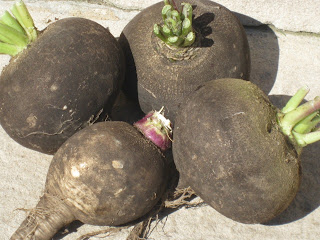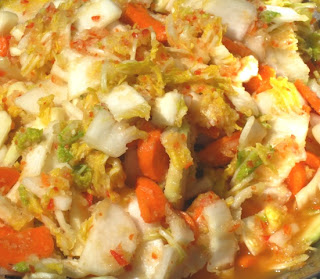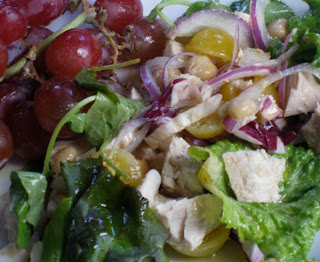 Tuna and chickpea salad with golden cherry tomatoes.
Tuna and chickpea salad with golden cherry tomatoes.Preparation time: 10 minutes
Shopping: none
This salad was tossed together with a can of tuna from the pantry, an opened can of chickpeas in the fridge, a few slices of red onion and some Dr. Carolyn tomatoes from the garden. It was displayed on this week's green salad mix already bagged in the refrigerator and dressed with the simple mustard vinaigrette we had on hand.
I also like this salad with the giant marinated white beans usually available in the cheese section at the local Whole Foods. (They used to be displayed at the olive station, but then showed up prepacked with the fresh mozzarella cheeses. Last I checked, they were sold out--hopefully this is not another one of those outstanding items Whole Foods quietly removes from the shelves.)
What is most intriguing to me about this dish, however, is the canned tuna. I buy a water-packed white albacore tuna labeled as "U.S. wild-caught." Since the dolphin controversy and the warnings about mercury content, there hasn't been much news about canned tuna, so I turned to the Monterey Bay Aquarium's "Seafood Watch" site for an update.
Perhaps more than most fish, tuna is a quagmire for anyone trying to purchase sustainable seafood. Starting with albacore, for instance, "Seafood Watch" pronounces Tombo, canned white tuna, longfin Tunny and Albacora a "best choice" if it's caught off British Columbia or the U.S., and if it's caught by trolling or with a pole. Also, the same varieties are a "best choice" if caught in Hawaiian waters by trolling, with a poll or with a handline. However, those vary same varieties caught in Hawaii using the "longline" method are merely a "good alternative."
The trouble with albacore starts when you get into those same varieties using those same methods "worldwide" (except Hawaii). In the case of "worldwide," you should avoid that can of albacore.
As for Skipjack tuna, including Aku, "Canned Light Tuna," Arctic Bonito and Striped tuna, the "best" choice is either "worldwide" caught trolling or with a poll, or from Hawaii caught trolling, with a poll or with a handline. Again, a "good alternative" is from the same varieties caught near Hawaii using the "longline" method. To be avoided are the "imported" varieties using the longline method.
No misunderstanding there, right?
Unfortunately, I don't think much of this information is listed on the cans available for inspection at the local grocery store, including the Whole Foods, which has numerous varieties available in a wide range of prices. Once again, it's buyer beware.





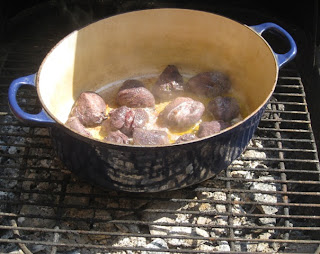


















 The "hot" pickles were prepared very simply, with crushed red pepper.
The "hot" pickles were prepared very simply, with crushed red pepper. Like this gentlemen, one of the McClure pickle clan, vendors at the Pickle Day festival take their pickling seriously. I could not help but notice the incredible whiteness the McClure pickles had maintained in the jar after
Like this gentlemen, one of the McClure pickle clan, vendors at the Pickle Day festival take their pickling seriously. I could not help but notice the incredible whiteness the McClure pickles had maintained in the jar after  Tasting consisted of spreads such as this one, where the pickles were cut into small pieces and displayed with toothpicks. It was no easy feat squeezing through the crowds to get at the pickle platters, and the pieces were small enough that they were not always so easy to spear with a toothpick.
Tasting consisted of spreads such as this one, where the pickles were cut into small pieces and displayed with toothpicks. It was no easy feat squeezing through the crowds to get at the pickle platters, and the pieces were small enough that they were not always so easy to spear with a toothpick.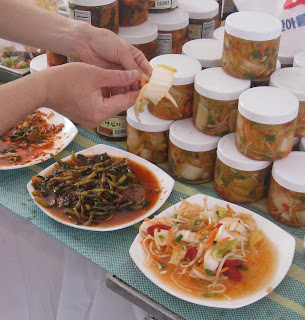 Here is some of the international flavor represented at Pickle Day:
Here is some of the international flavor represented at Pickle Day:  We sampled many different pickles and of the lot we were most impressed with this simple offering: pickled
We sampled many different pickles and of the lot we were most impressed with this simple offering: pickled 
 If sampling pickles stimulates your appetite, there were also food vendors who took advantage of the situation to make some brisk sales. Here, sausages and--what else?--sauerkraut.
If sampling pickles stimulates your appetite, there were also food vendors who took advantage of the situation to make some brisk sales. Here, sausages and--what else?--sauerkraut.





